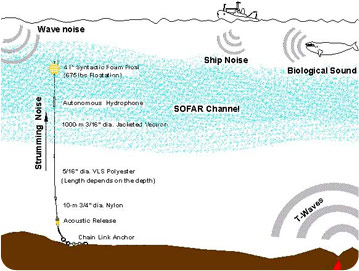Most of us think of the ocean depths as dark and silent -- like a giant sensory deprivation tank. But while they’re certainly dark enough, they’re not silent. Sound has no trouble traveling through the oceans. In fact, it travels much faster than it does in the air -- and a lot farther.
 Measuring sound in the ocean. Credit: National Oceanic and Atmospheric Administration
Measuring sound in the ocean. Credit: National Oceanic and Atmospheric AdministrationBecause water is denser than air, sound waves ripple through the oceans almost five times faster than through the air -- almost a mile per second.
But the speed can vary by a couple of hundred miles an hour. It travels faster through warmer water and through greater pressure.
Sound travels farthest as you go deeper into the ocean, along a boundary layer where the water stops getting colder and the greater pressure starts to affect the speed of sound. For most of the oceans, this “sound channel” is about two-thirds of a mile deep. Water above and below this layer “bends” the sound waves to keep them traveling along at the same depth. Sounds in this layer can travel for hundreds of miles -- and have even been recorded half way around the world.
Some recent research suggests that sound may travel farther through all the ocean layers in the not-too-distant future. The oceans are absorbing carbon dioxide from the atmosphere, which makes them more acidic. Under conditions that could prevail in just four decades, sound could travel up to 70 percent farther than it does now. The extra noise could help out some species that use sound for mating calls and hunting. But for others, the sound could do more harm than good.

